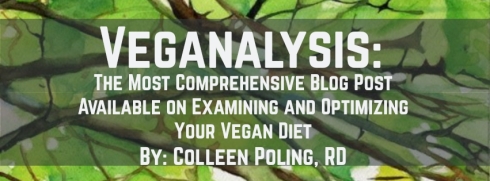
A vegan diet is about living more compassionately and more consciously. It is a lifestyle of pure intention. This purposeful way of living will bring you inner peace, and if done right, provide complete nutrition your body has never seen before! In this blog we explore the latest science in vegan nutrition. The complex science will be explained in an easy to understand way through infographics, easy to understand explanations and recipes. You will learn how to examine and how to optimize each of your organ systems by eating only plants, and apply it to your everyday life!
Part One: Examining Your Vegan Diet
1.1 Why are you Vegan? To be a healthy, balanced vegan you must Nourish the Body, Mind and Soul
- For a Nourished Mind: Chances are if you are vegan you are more intentional with the food you choose. Ask yourself these questions to see where your intention is. Do I know where my food comes from? Is it organic, local, fair-trade? Where was my food grown? Upgrade your choices, and choose foods that benefit your environment, community and the people who grow it. Are you connecting with your food? Know that after you eat your food it becomes a part of you. Try mindfully eating your food, enjoying every flavor and texture. Examine how you feel before and after eating and monitor the trends. Do you crave certain foods such as sugar? To nourish the mind we have to detach ourselves from the wanting of certain foods. Look at your food beyond the immediate gratification. The goal is to form a healthy relationship with food. Knowing that food is here to heal us, not harm us. We must see food for what it really is, a healing, energy source.
- For a Nourished Body: We hear in the media stories about celebrities like Beyonce going vegan for a month for health reasons. This can anger many long-term vegans, because it can portray the vegan diet as more of a diet than a lifestyle. I argue that this is a great place to start. You can still call yourself a vegan and eat potato chips, orange soda and Oreos all day, but why are you treating other animals with love and respect, but not yourself? To nourish the body, we have to feed it the right nutrients it needs to thrive. It can be done on a vegan diet, but must be managed thoughtfully with professional guidance.
- For a Nourished Soul: Believe it or not, the type of energy put into your food makes a difference. Try pouring as much positive energy into your food when growing and creating it as possible. Look where your food has been created, has it been lovingly created, and assembled? Or has your dinner been put together by disgruntled, underpaid food workers? Continue to choose non-animal dishes. Today’s factory farms are not like the ones most of us learned about in school; they are mechanized factories where an animal’s welfare is of little concern compared to profit. Veganism emerges as the lifestyle most consistent with the philosophy that animals are not ours to use. By eating this suffering, you are ingesting the energy of that animal who has suffered.
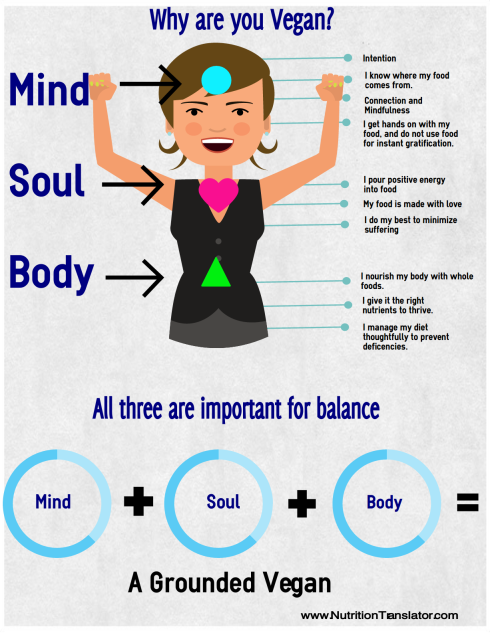
1.2 Are you a good role model?
Being a good vegan role model means being kind and leading by example. I understand that it can be frustrating to see people eating meat, visiting zoos and sea world, or wearing fur. The biggest impact I find is that when you are kind, compassionate and live your own life with conviction, others will see your transformation and want to learn more. Don’t put anyone down because of their choices. Chances are you ate meat and animal products at one point in your journey, so you should not judge others. Kindness is the key.
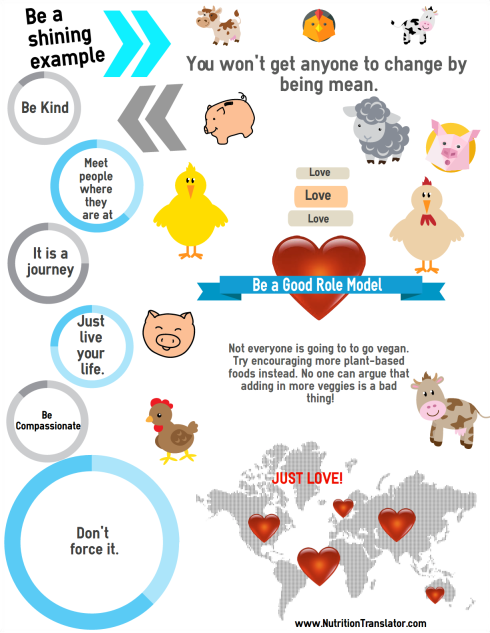
1.3 Are you getting enough variety?
- A varied diet makes sure you are covering all your nutritional bases. It keeps you safe and helps you avoid over-exposed to hazardous chemicals, or overexposure to one specific nutrient. For example raw spinach everyday in your morning smoothie may over expose you to too many oxalates.
- Veggies and Fruits/Antioxidants: Goal at least 6-11 cups/day of organic vegetables like asparagus, bok choy, broccoli, Brussels sprouts, cauliflower, celery, cabbage, cucumber, collards, kale, spinach, radishes, squash. These should be a mix between cooked and raw. 1 cup raw=1/2 cup cooked. Goal for at least 1-2 cups/day of low sugar fruit like fresh strawberries, cranberries, raspberries, blueberries for adequate antioxidants and polyphenols.
- Beans and Lentils/Protein: Choose at least 2-3 cups of whole plant based proteins like red lentils, chickpeas, black beans, pinto beans, red lentil, green lentils, mung beans. Be sure to sprout your beans and lentils to maximize the nutrients. Sprouting also helps to neutralize phytic acid and enzyme inhibitors which aids in better digestion and absorption of important nutrients like zinc copper, iron, magnesium and calcium. The goal is to completely avoid processed fake meats. To calculate you protein needs take your body weight in KG (divide pounds/2.2 to get KG), and that will be approximately how much protein you need per day in grams for the average person. Multiply your weight in KG by 1.2-1.5 if you are an athlete, or wanting to build muscle. If you need more protein try a plant based protein powder like Sunwarrior or Vega Sport.
- Nuts and Seeds/Fat: Get in 2-4 servings of nuts and seeds like, almonds, walnuts, macadamia nuts, chia seeds, hemp seeds, pumpkin seeds, watermelon seeds for fiber, healthy fat, vitamins and minerals. Choose sprouted varieties when possible. We will talk more about fat when we get into optimizing 2.1, 2.7 and 2.9, but I want to encourage you to NOT shy away from fat. Getting enough healthy fat (30-50% of your total calories/day) will help absorb certain nutrients like Vitamins A,D,E,K, sustain a healthy brain/nervous system, cardiovascular system, reproductive system, healthy functioning mitochondria, and prevent mood disorders. Getting enough fat will help your body and mind stay energized all day long. Choosing a total fat intake of 5-9 servings per day including the 2-4 servings of nuts, seeds, and also including also avocados, olives, walnuts, olives, and oils like extra-virgin olive oil, coconut oil, algal oil, Brain Octane by Bulletproof are all great choices. It is a good idea to avoid all vegetables oils like canola, safflower, sunflower, corn, soybean, and peanut oil. These types of fats (PUFAS) are now showing a higher connection with heart disease due to the high amounts of Omega-6’s in them. Completely avoid margarine that contain trans fat or partially hydrogenated oils.
- Grains/Carbohydrates: Don’t go overboard on grains. The goal is to keep our blood sugar and insulin levels from spiking all the time. Sometimes on a vegan diet we can lean more toward a grain/carb centric diet. Ideally only 1-3 servings of grains per day. Choose wild rice, forbidden rice, quinoa, brown rice. When possible, instead of grains, choose other carbohydrates like sweet potatoes, yams, carrots, butternut squash, pumpkin, plantains for complex carbs, additional vitamins and minerals, and variety. Try to avoid gluten if you can. There are so many other types of grains to choose from than gluten! Give amaranth a try, for example! Do you best to limit added sugars, even in the forms of agave, maple syrup, and coconut sugar. Try a natural sugar alternative like a monkfruit sweetener, or non-GMO xylitol, or non-GMO erythritol. Lakanto makes a great one with a combo of monkfruit and erythritol.
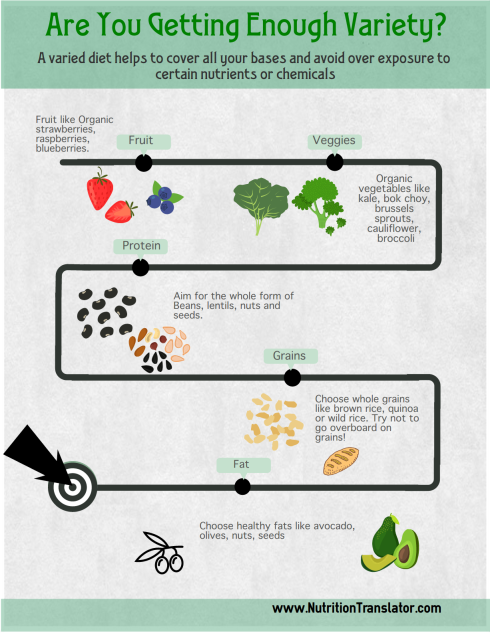
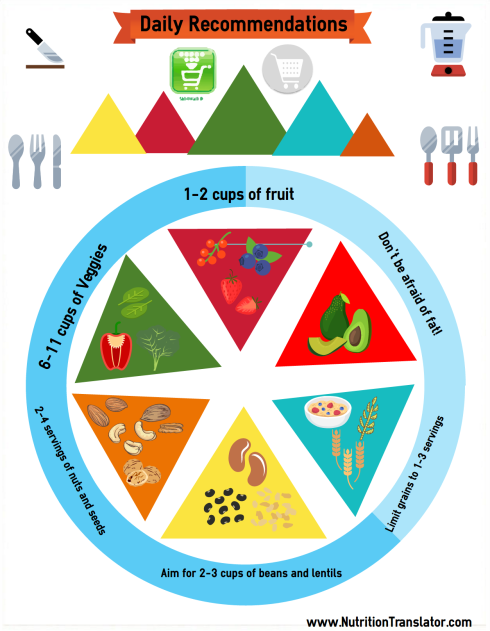 1.4 Are you deficient?
1.4 Are you deficient?
- Being on a vegan diet requires special attention and proper managing to get the right nutrients. There are too many stories to count with vegans who start off feeling great for the first couple years, but then start to experience fatigue, sickness, hair loss, anxiety, diminished sex drive, and mental breakdowns. As a solution to this, a properly managed vegan diet can provide “gene therapy in the kitchen,” and keep you feeling amazing for a lifetime!
- Ask yourself, How do I feel on a regular basis? Am I tired, sluggish and dragging towards the end of the day? Am I experiencing brain fog, or reduced concentration? Do I have mood swings, or bouts of depression? Am I an athlete with increased fatigue? These are all examples of possibilities that you are not getting enough of the right nutrients, and/or your mitochondria are not functioning properly.
- It is important to look at your blood work to monitor trends, and to see what is going on inside. Get these nutrients to get tested yearly-
- 25(OH)D, CMP, CBC, ferritin, Total iron binding capacity, Cortisol, Omega 3 (DHA, EPA), RBC magnesium, RBC Folate, Copper, Zinc, B12, Homocysteine, CRP, Serum Methylmalonic Acid, Iodine, T3, T4, TSH, Lipid Panel
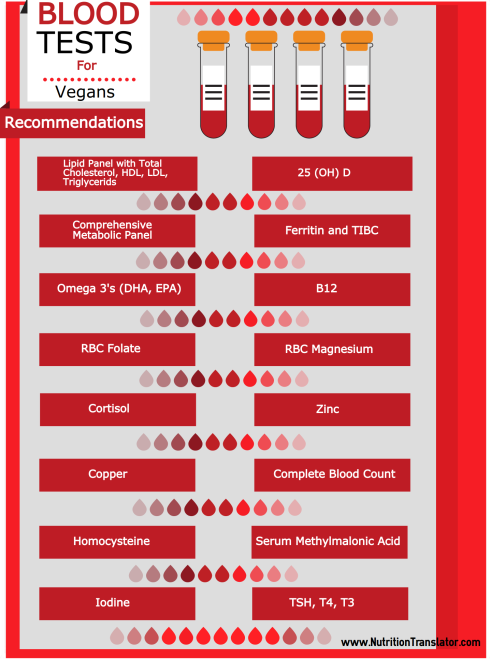
Part Two: Optimizing your Body Systems
2.1 Brain Power: Nervous System
- DHA: Many if not all vegans are not getting enough of this vital omega 3 fatty acid. If you are getting omega-3s in the form of hemp seeds, chia seeds, and ground flax seeds for example then great! However, you will not be able to convert enough over of this ALA form, to the DHA and EPA forms. If you are insulin resistant, deficient in certain vitamin or minerals like zinc, magnesium, biotin, Vitamin B3, B6, C, stressed, male, or at an advanced age, you will be converting over even less. DHA is such an important nutrient because a deficiency can result in serious mental and physical health problems. DHA is the primary structural component of the brain and the retina. Especially if you are pregnant or breast feeding, your baby is dependent on the omega 3 from your diet, which can impact the brain and eye health of your growing child. DHA helps to protect the vascular system, combats cancer, adequate learning and memory, prevents Alzheimer’s, and increases the production of the master antioxidant, glutathione in the body. It also turns on a gene to make a growth hormone called Brain-Derived Neurotrophic Factor (BDNF). BDNF is known for making new brain cells. Most people and especially vegans are consuming far to many omega 6’s than omega 3’s which causes inflammation. So do your best to reduce or eliminate vegetable oils in your diet, and get omega 6’s in the whole forms of nuts/seeds. Please start incorporating a EPA/DHA supplement in the form of algal oil daily to raise your levels of omega 3. Pure Encapsulations makes a great vegan supplement. Also Pure One and Dr. Furman do as well.
- Curcumin: The ancient Indian healing spice turmeric is capable of improving cognition, mood, alertness and contentedness. It also has been shown to significantly improve performance on sustained attention, working memory tasks, and preventing/fighting depression. Turmeric has a powerful compound in it called Curcumin which has the ability to: Protect against oxidative stress caused by physical or emotional stress. Oxidative stress causes damage to our cells and genes that can result in certain types of cancers. Chronic inflammation makes you feel lousy, it stops your body from working as well as it could, and it can also contribute to other problems like insulin resistance or metabolic syndrome down the line. Curcumin is neuroprotective, promotes neurogenesis and neuroplasticity. This basically means you get smarter and improve your memory. It can improve the functioning of your neurotrasmitter systems. So, this means it can improve your mood. Curcumin has been shown to inhibit a type of degenerative brain plaque found in Alzheimer’s disease. Be sure to get in turmeric in at least 3x a week. If you have a lot of stress in your life, or are an athlete I recommend taking a curcumin supplement with black pepper and a fat source for the best absorption.
- Folate and B-12: Adequate levels of folate are essential for brain function, and folate deficiency can lead to neurological disorders, such as depression and cognitive impairment. Getting enough folate in conjunction with other B vitamins such as B12 has been shown to be effective at preventing cognitive decline. Supplementation with B12 is essential for all vegans to help prevent functional folate deficiency, prevent elevated levels of homocysteine, prevent macrocytic anemia, and irreversible neurological damage . Recommended 1 mg 2x a week. Please do not rely 100% on fortified nut milks, cereals for your B12.
- Other important nutrients: Vitamin A, Vitamin E, Vitamin D, Choline, Calcium, Zinc, Selenium, Vitamin C, Copper, Iron, tyrosine, polyphenols, caprylic acid.
- Summary: Take a DHA/EPA supplement everyday, and aim for 1000-2000mg of combined DHA/EPA daily split between 2 doses. Have at least 3 recipes with turmeric a week, with a goal of 7-10 tsp/week of organic turmeric powder combined with black pepper and fat source. Supplement with curcumin if you are highly stressed or an athlete, 500-1000mg/day with black pepper included in supplement, and fat source. Take a B12 supplement daily or weekly minimum 1-2mg/week in supplement form, bonus with nut milks, and fortified foods. Consider a vitamin C supplement boost the conversion from dopamine to norepinephrine. Be sure to create weekly recipes with foods such as sweet potatoes, carrots, almonds, beans, leafy greens, avocado, Brazil nuts, cashews, broccoli, chickpeas, black-strap molasses, black pepper, pumpkin seeds, cocoa, dark, chocolate, pomegranates, berries, grape seeds, coconut milk, brain octane oil, and lentils to hit the important brain-boosting nutrients like choline, flavonoids, antioxidants, B Vitamins, Vitamin C and E. For a bonus include the medicinal mushroom lion’s mane for increased creativity and memory.
Recipe: Brain Boosting Buddha Bowl
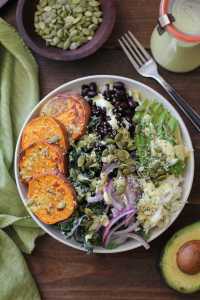
Bowl: 1 serving
- 2 cups Leafy green mix of spinach, romaine lettuce, arugula
- 1/4th cup cooked Quinoa
- ½ Avocado
- 1/4th cup Pumpkin Seeds
- ½ cup cooked and chopped Sweet potatoes
- ¼ cup shredded Carrots
- ¼ cup sliced Strawberries
- ½ cup chickpeas or black beans, drained from can and rinsed
Dressing 6-8 servings
- 1/2 cup Braggs Apple Cider Vinegar
- 4 tablespoons organic sesame tahini
- 2 tablespoons organic turmeric
- 3 cloves garlic, peeled
- 2 tablespoons nutritional yeast
- 1 tablespoon Lakanto Monkfruit Sweetener
- A pinch of cayenne pepper
- A pinch of Celtic or Himalyan Sea Salt
- 2 tablespoons Thrive Oil
- 3-4 drops Pure One or Dr. Fuhrman’s EPA/DHA purity
- 1/2 cup filtered water
Directions:
- Mix all the Buddha bowl ingredients in a bowl and drizzle with dressing. Keep leftover dressing in container with a lid. Enjoy!
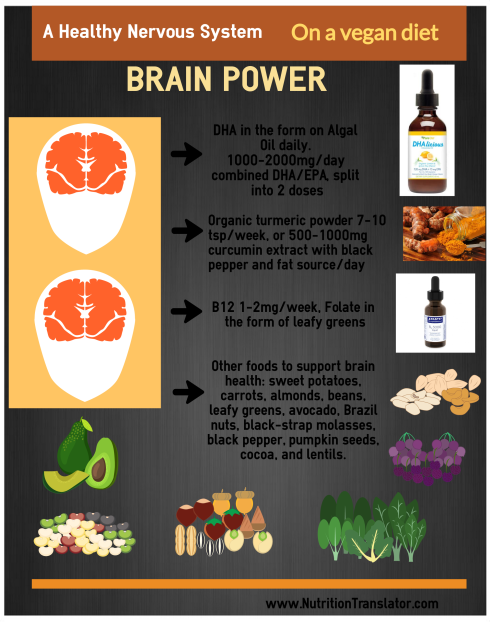
2.2 Gut Health: Digestive System
- Your health depends on your gut bacteria! Did you know that you have about 3-5 pounds of microbes in and on you right now? The bacteria in your gut are especially important, and we need to take a closer look at them. These resident microbes within the body, collectively called the microbiome, regulate inflammation, digestion, immunity, production of various vitamins, detoxification, carbohydrate metabolism, and even the production of important neurotransmitters like serotonin and dopamine. Researchers are now also able to identify patterns in the types of bacteria in the gut that may either correlate with obesity and metabolic syndrome. Increasing the diversity of the gut bacteria can help to manufacture some of the vitamins and cofactors needed for building bones, including B6, B12, and K. Scientists also suspect that a healthy gut flora helps the body properly digest calcium, and increases vitamin D receptor expression. You want to try to avoid antibiotic use unless it is absolutely necessary, and also include more prebiotic and probiotic foods in your diet.
- Prebiotics: These feed the good bacteria in our gut. Prebioitcs include garlic, onion, Jerusalem artichokes, asparagus, dandelion greens, baobab tree powder.
polyphenols. - Probiotics: These contain the friendly bacteria themselves, such as kombucha tea, water kefir, kvass, rejuvelac, fermented veggies like kimchi, sauerkraut, and fermented soybeans like natto.
- Summary: By limiting antibiotic use, and including a diet rich in probiotics, and prebiotic foods you will create an extremely diverse microbiome. Also try to limit sugar intake, and choose organic foods or at least non-GMO foods. Glyphosate, the active ingredient in Roundup on all GMO foods can disrupt the microbiome. Also do your best to avoid aspartame which can also disrupt the microbiome. Include a tablespoon of apple cider vinegar in a glass of water each day to help improve digestion.
- Recipe: Digestive Drink
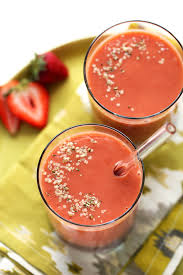
Ingredients:
- 1 Tbsp Baobab Powder
- 1 cup Cashew Kefir
- 1 cup Coconut Milk
- 3 Tbps Hemp seeds
- ½ cup Strawberries
- 1 Banana
- 1 scoop Vega-one all in one nutrition drink, Plain, Unsweetened
Directions:
- Blend all ingredients in a high powered blender. Enjoy!
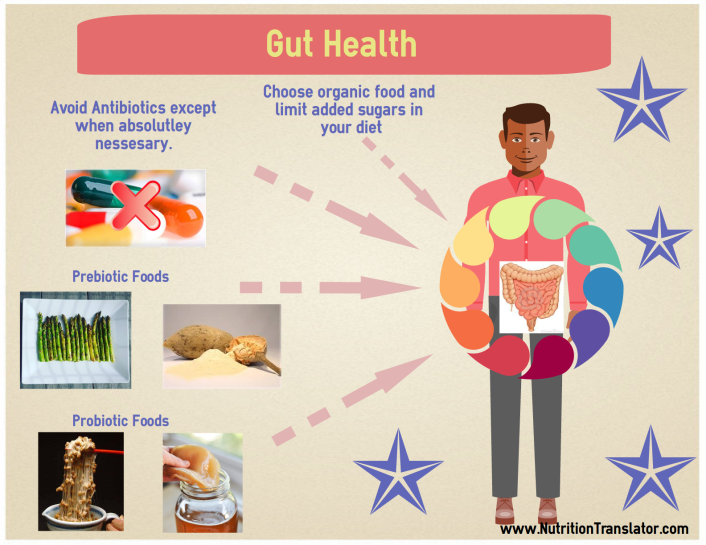
2.3 Strength: Muscular System
- Amino Acids: We cannot talk about a vegan diet without going into protein. All cells in the body contain protein. There are proteins in cartilage, ligaments, bones, hair, skin, and hemoglobin called structural proteins. There are pigment proteins such as melanin that determine the color of your eyes, hair and skin. There are clotting proteins that are needed to clot our blood. Certain hormones such as insulin is a protein that acts as a chemical messenger, which regulates body processes and responses. Enzymes are proteins. There are transport proteins such as hemoglobin, which transports oxygen to the tissues. And of course we all know that proteins make up the muscles, which enable us our muscles to move. Amino acids are the building blocks of protein. Think of amino acids like charms on a chain to amino acids make a beaded bracelet. There are 20 different amino acids that can make up these bracelets. There are 9 amino acids that must be supplied by the diet. These are considered essential amino acids. The body can make the rest of the 11 amino acids. However, under certain conditions some nonessential amino acids can become essential. Where should we get our essential amino acids? How can we be sure we are getting enough of the essential ones? If we are vegan, do we need to combine different plant sources together? Great questions! Nearly ALL foods contain some protein, but no natural food is 100% protein. That is right, even strawberries contain protein! Animal products contain high amounts of the 9 essential amino acids. Plants contain all the 9 essential amino acids, but may be lower in one. Does this make plant protein inferior?? NO! because the plants do contain all essential amino acids. As long as your body is getting as much protein as it actually needs per day, and is provided lots of variety, it doesn’t matter what form the protein comes in. You also don’t have to worry that you won’t get enough usable protein if you don’t put together some sort of magical combination of foods at each meal.
- BCAA: Leucine, isoleucine, and valine are considered the Branch-Chain Amino Acids. The structure of these amino acids allow your body to transport BCAAs directly from the liver to the bloodstream, while other amino acids are subject to a more complex metabolic cycle. BCCAs perform a number of functions, but compared to other amino acids, BCAAs are more involved in stimulating muscle growth. BCAA supplementation can promote muscle protein synthesis and increase muscle growth over time. Keep in mind too, that muscle growth also requires load and movement. BCAA have also been shown to suppress cortisol levels, reduces inflammation, increases testosterone, and reduces muscle soreness post exercise which helps you recover faster. Good sources of plant-based BCAA are Leucine: beans and lentils, Isoleucine: almonds, cashews, and chickpeas, Valine: peanuts, sesame seeds, beans, and lentils. You can also choose a plant-based protein supplement that contains BCAAs, such as Vega Sport Performance Protein which has 6 grams of BCAAs per scoop.
- Magnesium: This nutrient is important for over 300 enzymatic reactions in the body, is involved in ATP production, and also important for a healthy muscular system. Over 75% of the population is deficient due to soil depletion and poor farming practices. Magnesium deficiency is a serious problem. And because magnesium operates on a cellular level as a “key” to over hundreds of biochemical reactions, symptoms of deficiency may overlap those of alternate causes. Magnesium is important to support muscle recovery after exercise and for ATP production. Taking Magnesium orally can sometimes cause some GI distress, so I recommend using the transdermal method. Spray Magnesium oil, Ancient Minerals, on 20 minutes before your shower. It can be sprayed directly on sore muscles or on the thighs for better absorption.
- Other important nutrients: calcium, potassium, Vitamin C, Thiamine, Sodium, Iodine, and water
- Summary: Protein combining is a myth and as long as you have a balanced diet with a variety of foods such as hemp seeds, beans, lentils, nuts, seeds, leafy greens you will be meeting your needs. If you have high needs, such as athletes, consider a protein powder or protein bar like Garden of Life or Sunwarrior brands. Include magnesium rich foods like spinach, chard, pumpkin seeds, but also consider a topical magnesium spray due to the depletion of magnesium in our soil.
- Recipe: Weight Lifting Wraps, 4-6 servings
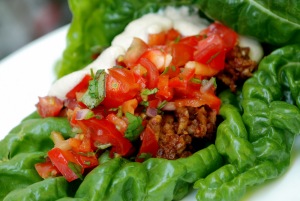
Walnut Taco Mix:
- 2 cups raw walnuts
- 2 Tbsp coconut aminos
- 1/8 tsp Aleppo chili flakes
- 1 tsp ground cumin
- 1 tsp extra virgin olive oil
Directions: Put all ingredients in a food processor and pulse just to mix. Don’t over-blend, or you will end up with walnut butter!
Cashew “Sour Cream:”
- 1/2 cup raw cashews, soaked overnight or at least 2 hours
- juice of 1/2 lemon
- 1 tsp apple cider vinegar
- 5 Tbsp water (approx.)
Directions: Put all ingredients except water in a high speed blender or food processor and blend, adding water one tablespoon at a time until the desired consistency is reached. If you want a thick cream, use less water, for a thinner sauce, use more. (You will not achieve a perfectly smooth sauce with a food processor, but it is still delicious!)
Wrap:
Directions: Remove stem from Swiss chard and top with walnut meat, favorite salsa, “sour cream” and avocado. Garnish with extra cilantro. Wrap and eat!
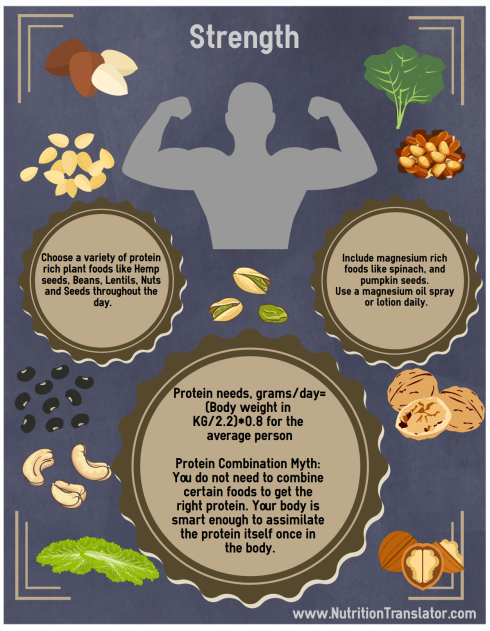
2.4 Fighter: Immune System
- Glutathione: is the master antioxidant in the body. It such an important antioxidant because it is inside our cells. Research is showing that it is pivotal to health, and the amount of glutathione in our cells can predict how long we will live. Glutathione deficiency causes cells to be more vulnerable to oxidative stress, which contributes to cancer development, and stresses the immune system. To increase glutathione, eat at least 1 cup of sulfur rich veggies like broccoli, cauliflower, Brussels sprouts, kale, Bok Choy, 1 serving of high folate foods like sprouted lentils, avocado, spinach, garbanzo beans, which which help with methylation. DHA and turmeric will increase your glutathione levels. In addition to eating these foods, taking an absorptive glutathione supplement during times of sickness, travel or high stress can be very beneficial.
- Selenium: Selenium is a potent nutritional antioxidant, that boosts our immune systems. Adequate selenium intake helps to increase glutathione. Selenium can protect the deepest part of your body’s cells – the nucleus which contains your genes (DNA). People who don’t get enough selenium in their body are more likely to suffer with fatigue and swollen glands, as their body struggles to overcome infections. Unfortunately, it is very difficult to obtain sufficient selenium through your diet, as very few foods are a rich source of this important mineral. Our food is an unreliable source of selenium due soil depletion and poor farming practices. So while consuming a variety of foods known to be high in selenium like Brazil nuts, Pinto beans, Shitake Mushrooms, Reishi Mushrooms, Chia seeds, Green veggies, it is also a good idea to add a couple drops of Trace Minerals to your water each morning.
- Zinc: Zinc is known to play a central role in the immune system. Your white blood cells simply can’t function without zinc. Zinc has been shown to reduce the severity of the common cold in humans and possibly shorten its duration. Zinc also functions as an antioxidant and can stabilize membranes. Zinc is also needed to convert Beta-carotene to Retinol. Like selenium it can be hard to get enough Zinc while on a strict plant-based diet, because our soil is so depleted of these precious minerals. Choose foods known to be high in zinc like pumpkin seeds, cashews, peanuts, cacao, tahini, and almonds. Consider taking an all in one multivitamin like Thorne Research 2 a day to getting adequate cheated zinc for better absorption (note this supplement’s vitamin D is made from lanolin). This vitamin will also include selenium. Be sure to choose spouted foods and to increase absorption. Sprouted foods reduce the phytates that can decrease the zinc absorption. If you have a chronic disease like Chron’s disease, IBS, or diabetes you will want to increase your intake of zinc.
- Others nutrients to boost immunity: Vitamin C, Vitamin E, Iron, Vitamin A, Folic Acid, B6, B12, Thiamine, Riboflavin.
- Summary: Along with not smoking, regular movement, maintaining a healthy weight and blood pressure, getting adequate sleep, and limiting alcohol intake, be sure to eat at least 1 cup of sulfur rich foods to increase glutathione, and a liposomal glutathione supplement during high stress times (sickness, post-surgery, work, family stress, intense, exercise). Zinc and Selenium are key minerals to get enough of keep your immune system strong. Eat zinc and selenium rich foods throughout the day, and consider a supplement such as a multivitamin that includes both. Vitamin C rich foods are also important for immune strength.
- Recipe: Immune Elixir, serves 4-6
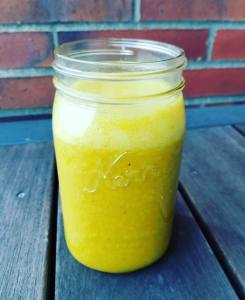
Ingredients:
- 1 tsp Ground turmeric
- 6 Lemons, pealed
- 1-2 tsp 10 mushroom blend Four Sigmatic
- dash of Cayenne Pepper
- 10-20 drops of Trace mineral drops
- 1 grain size amount of Shilajit
- ½ cup Filtered Water or Coconut Water
Directions:
- Blend ingredients in a high powered blender. Serve in shot glasses.
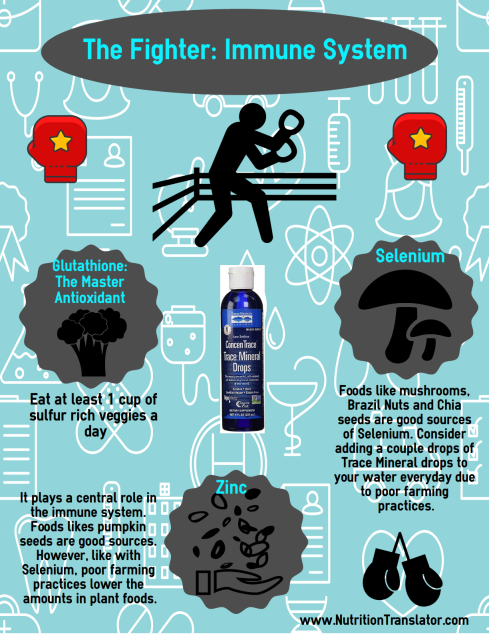
2.5 Balancing Hormones: Endocrine System
- Thyroid: The thyroid, found in the neck next to your voice box, is the master controller, that regulates nearly every major metabolic function in the body. Your Thyroid hormones affect your metabolism. We need dietary iodine to synthesize thyroid hormones. For those with healthy functioning thyroids, it is important you are eating iodine rich foods like seaweed in your diet daily. Try adding Kelp granules on top of you salads. Or try pan-frying some whole leaf dried dulse in avocado oil over medium heat until crisp, to create a bacon like flavor. Still not so sure? Try this product which has pickled beets, dulse and kale! Take note that some with hypothyroidism, excess iodine can worsen the condition. It you have a thyroid condition do not completely shy away from foods like Bok choy, Kale, Brussels sprouts, cauliflower, broccoli. Though they do contain goitrogens, the benefits outweigh the downsides. Be sure to cook them, this can substantially reduce the goitrogenic substances.
- Adrenal and stress management: Stress and overstimulation of the adrenal glands can increase the hormone cortisol. Increased cortisol causes inflammation. In addition to high cortisol levels, those with chronic stress can have low levels of DHEA. DHEA is considered the parent hormone, responsible for creating other necessary hormones within the body. Are you getting enough sleep? How high is your stress level? Are you over exerting yourself with exercise? If so, how can you manage this better?
- Blood Sugar Regulation: Eat every 3-4 hours, reduce added sugars, avoid white pasta, bread, flours and aim for whole plant based foods to maintain healthy blood sugar levels throughout the day.
- Summary: Healthy adrenals, blood glucose management and stress management will all impact the thyroid. So, it is not only is it important to manage these individually for overall health, but also for thyroid health. Try to get 7-9 hours of sleep each night, reduce added sugars, reduce caffeine, reduced processed vegan food, avoid vegetable oils, and manage your stress maybe with breathing exercises, yoga or meditation. Consider using lavender oil before bed to help with sleep and stress. Use a red-light app on your phone before bedtime to limit blue light from devices. If you have a well-functioning thyroid then be sure you are eating iodine rich foods like seaweed, and selenium rich foods like Brazil nuts regularly.
- Recipe:Balancing Brazil Nut “Tuna” Serves 6-8
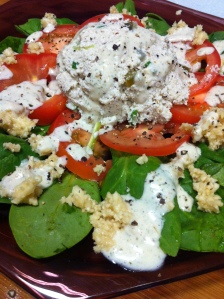
Ingredients:
- 1 cup raw Brazil nuts – soaked for two hours
- 1/3 cup canned organic chickpeas
- juice of one lemon
- 1 tbsp unfiltered apple cider vinegar
- 1 clove garlic – pressed
- 1/4 tsp sea salt
- 1/4 tsp dry mustard
- 1/2 tsp kelp powder
- 1/4 tsp pepper
- 2 green onions diced
- 1 celery stalk diced
Directions:
- Drain and rinse Brazil nuts and sunflower seeds. Add all base ingredients except green onions and celery into processor and mix until it is almost a paste. Put paste in bowl and mix in green onions and celery. Eat immediately or let refrigerate. Will keep if sealed for 5 days.
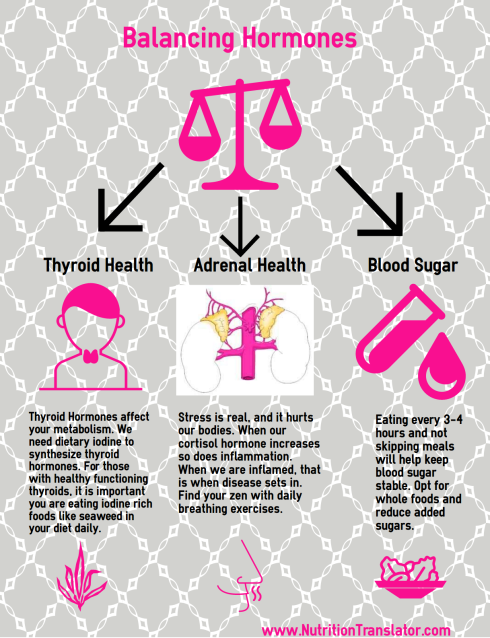
2.6 Bones: Skeletal System
- Vitamin D3: Unless you are a lifeguard in Southern California, there’s a decent chance you’re deficient, especially if you live at a far northern latitude. We need to make sure we are getting enough vitamin D3 because if we are deficient then we will not be absorbing the calcium from our food. If it is not being absorbed, than calcium will be taken from the bones and teeth. Vitamin D3 is also important for balancing mood so it is connected with brain health and also immune health. I recommend getting you blood tested every year for Vitamin D. If you are low, you will need to supplement. Taking 1,000 units/day is usually a good idea for maintenance.
- Calcium: We all know that we need calcium for strong bones. In addition to making sure we are meeting our vitamin D requirements, eating calcium rich foods on a daily basis will ensure we met our needs. Eating 1-3 cups of sulfur rich vegetables will give you plenty of calcium. Foods also high in calcium are sesame seeds, apricots, almonds, blackstrap molasses, chia seeds and Brazil nuts.
- K2: Vitamin K2 is critical for a healthy heart and skeletal system. This vitamin is often overlooked in the vegan diet. Among other things, K2 helps shuttle calcium away from your arteries (where it can contribute to plaque formation), and into your bones and teeth, where it rightfully belongs. Some K1 is converted to K2, but not much. As you are probably learning from this blog, it is not ONLY about what you eat but also what you absorb and convert that really matters. Vitamin K2 is only found in certain bacteria and animal products. We can get it through a fermented food called Natto or a supplement. K2 has incredible dental benefits as well. I recommend all vegans take a daily K2 supplement if they are not consuming natto on weekly basis. Consider trying the protein powder by Sunwarrior called Illumin8 which has natural sources of K2.
- DEXA Scan: Consider getting a DEXA Scan done, which is a special type of X-ray to measure your bone density on a yearly basis.
- Resistance Training: To keep strong bone density and maintain muscle mass, regularly do resistance training with weights 2-3x a week.
- Summary: The first step to strong bones is to see what level your Vitamin D level is at. From there you can see if you need to supplement. Vitamin D will facilitate the absorption of calcium from your food. If you are low in vitamin D, most that wonderful calcium rich plant food you are eating will not be absorbed, and worse you will be pulling calcium from your bones and teeth. Now, once you have normal levels of vitamin D, and are eating lots of calcium rich plant foods, it is vital you are getting enough vitamin K2 to shuttle all that calcium to the right places, your bones and teeth. We do not want the calcium to go to the arteries. Consider eating more Natto or supplementing with K2. Getting a DEXA scan yearly can help you monitor your bone density trend. Keep your bone density strong with resistance training 2-3x a week.
- Recipe:Strong Bones Stir-Fry, Serves 6-8
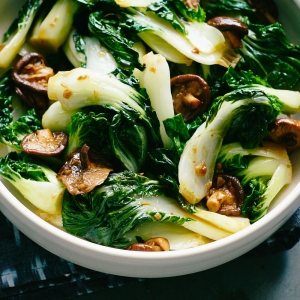
Ingredients:
- 3 pounds baby bok choy
- 1 tablespoon coconut oil
- 3 small dry red Chinese hot peppers
- 1 pound shiitake mushrooms (about 4 dozen), stems removed
- Salt and pepper
- 4 garlic cloves, minced
- 1 tablespoon grated ginger
- 1 tablespoon lakanto monkfruit sweetener
- 3 tablespoons coconut aminos
- 2 cans navy beans, rinsed from can
- 6 scallions, sliced diagonally, for garnish
- 1 tablespoon roasted sesame seeds and almond slivers for garnish
Directions:
- Bring a large pot of well-salted water to a boil. Cut off and discard stem ends of bok choy. Separate leaves, rinse and drain. Drop leaves into boiling water and cook for 1 to 2 minutes, until barely cooked. Immediately remove, rinse with cool water, drain and pat dry. Arrange leaves in one layer on an ovenproof earthenware platter, then set aside.
- Put a large wok or cast-iron skillet over high heat. Add oil and heat until nearly smoking, then add hot peppers and shiitake caps, stirring to coat. Season lightly with salt and pepper. Stir-fry for 2 minutes. Reduce heat slightly and add garlic, ginger, Lakanto, and coconut aminos. Stir-fry for 1 minute more.
- Spoon shiitake and pan juices over reserved cooked bok choy. Serve at room temperature, or if you prefer, reheat covered with foil for 10 to 15 minutes in a hot oven. Fold in navy beans and garnish with scallions and sesame seeds, and almond slivers. Serve with a side of natto.
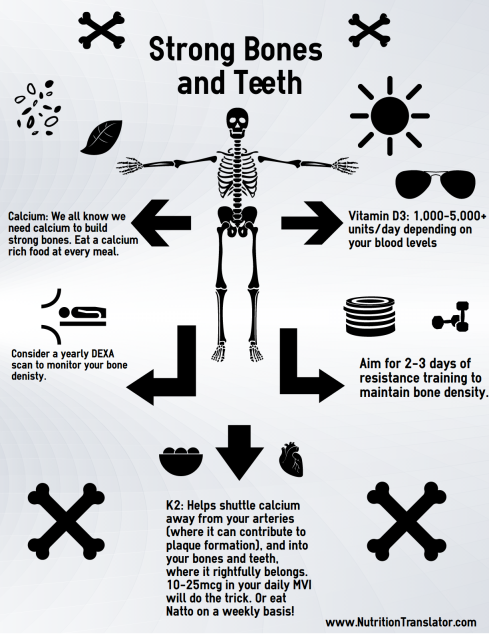
2.7 Love your heart: Cardiovascular System
- Iron: Getting enough iron in your diet, and absorbing that iron is vital to heart health. Low iron can lead to anemia, or a low hemoglobin level in the blood. Iron deficiency can often be linked to heart disease because the heart has to work harder to pump more blood and oxygen through the body. Combining iron-rich foods with vitamin C helps the absorption.
- Healthy Fats: Choosing healthy fats instead of damaged, or vegetable oils. Do your best to avoid fried food, and vegetable oils like canola, corn, soybean, sunflower, safflower, peanut, cottonseed, which contain high amounts of omega-6 fatty acids. It is ok to have some Extra-Virgin olive oil or avocado oil in your diet, but avoid cooking them at high temps. Use coconut oil for cooking.
- K2: Coming back to K2 again. The K2 will help shuttle the calcium that is absorbed to the right places, bones and teeth.
- Spirulina: can prevent LDL cholesterol from becoming oxidized which helps prevent heart disease.
- Copper: Insufficient copper intake is associated with increases in cholesterol levels, clot formation, and heart disease.
- Summary: To ensure you are getting enough iron on a vegan diet, be sure to combine iron-rich plant foods with vitamin C-rich plant foods. For a healthy heart we must make sure our iron levels are within normal limits. Eat healthy fats such as avocados, nuts and seeds and stay away from vegetable oils. K2 will help shuttle the calcium to your bones and teeth where it belongs. Consider a K2 supplement, or make sure your multivitamin has K2 in it. Superfoods Spirulina and Raw Cacao contain nutrients which protect your heath, so consider adding the spirulina and copper rich foods like raw cacao in your diet.
- Recipe:Heart Health Vitality Balls, makes 15-20 balls
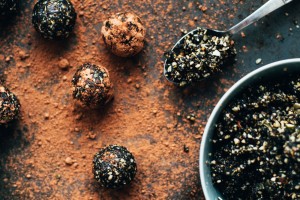
Ingredients:
- ⅓ cup almonds
- ⅓ cup brazil nuts
- ⅓ cup pumpkin seeds
- 1-2 tbsp spirulina powder (adjust to your palette)
- 1 ½ tbsp raw cacao
- 2 tbsp almond butter
- 8 dried apricots
- 8 pitted medjool dates (the stickier the better, if too dry soak for 15 min)
Directions:
- To prepare, place almonds and brazil nuts in food processor and pulse until it is a rough meal with small bits of nuts still left.
- Add pumpkin seeds, spirulina and raw cacao powder and pulse a couple of times to mix and crush the seeds.
- Add the almond butter butter, pitted medjool dates and dried apricots and pulse/mix.
When the mixture is combined but still a little rough, sticking together when you press it between your fingers, remove it from the food processor. - Press/roll into balls, roughly the size of half a golf ball. I
- if you wish roll in coconut and keep in the fridge for 5-7 days or freeze for a later date.
- Enjoy as a healthy protein packed snack.
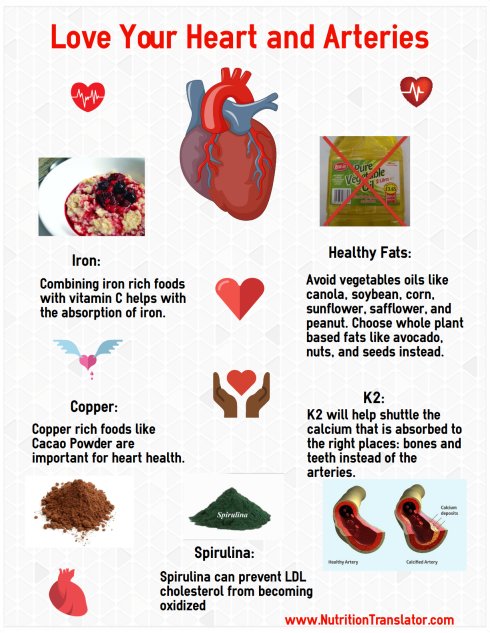
2.8 Beautiful Skin: Integumentary system
- Biotin and Vitamin C: Biotin and Vitamin C are nutrients that helps us keep a young, attractive appearance since it plays a major part in maintaining the health of our hair, nails and skin.
- Microbiome/Sugar: Keeping a healthy gut flora and diverse microbiome helps with healthy skin. Sugar intake can interrupt the microbiome and also cause spikes in blood sugar which can impact the skin.
- Vitamin E: Infused with antioxidant properties it aids in maintaining a youthful glow by warding off free radicals. Vitamin E rich foods help in delaying aging process, and also help in preventing skin pigmentation.
- Skin care products: The skin is the largest organ in the human body, and it’s the one that receives the most abuse from the sun, the pollution in the air, and destructive toxins we put on our skin. So choose natural products to put on your skin. The best one…coconut oil!
- Moringa: This superfood is high in many nutrients, and also wonderful for the skin. Try making a mask out of it with apple cider vinegar and turmeric or adding it to your morning smoothie!
- Spices: Spices like fresh ginger, cumin, coriander, thai basil, rosemary and oregano contain many healthy chemicals as we learned about turmeric. These polyphenols from the spices enrich the skin when added to the diet.
- Summary: Your skin is our largest organ and our first line of defense. It is one of the most meaningful ways we connect with one another whether that be a handshake, a hand on the shoulder or a warm hug. So treat it well by including Biotin rich foods like chard, vitamin rich foods like citrus and berries, vitamin E rich foods like nuts and seeds, reducing added sugars, adding in superfoods like moringa and spices. Avoid putting harsh chemicals and skin products on your skin, and choose natural products like coconut oil!
- Recipe:Healthy Skin Stuffed Peppers, Serves 4
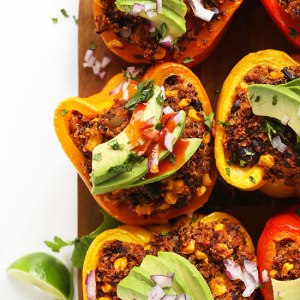
Ingredients:
- 1 cup (168 g) quinoa or rice, thoroughly rinsed and drained
- scant 2 cups (460 ml) vegetable stock (sub water, but it will be less flavorful)
- 4 large red, yellow, or orange bell peppers, halved, seeds removed
- 1/2 cup (120 g) salsa, plus more for serving
- ½ cup chopped chard
- 1 Tbsp (4 g) nutritional yeast (optional)
- 2 tsp cumin powder
- 1 1/2 tsp chili powder
- 1 1/2 tsp garlic powder
- 1 15-ounce (425 g) can black beans, drained (if unsalted, add 1/4 tsp sea salt)
- 1 cup (168 g) whole kernel corn, drained
Toppings:
- 1 ripe avocado, sliced
- Fresh lime juice
- Hot sauce
- Cilantro, chopped
- Diced red onion
Directions:
- Add quinoa and vegetable stock to a saucepan and bring to a boil over high heat. Once boiling, reduce heat, cover, and simmer until all liquid is absorbed and quinoa is fluffy – about 20 minutes.
- Preheat oven to 375 degrees F (190 C) and lightly grease a 9×13 baking dish or rimmed baking sheet.
- Brush halved peppers with a neutral, high heat oil, such as avocado or refined coconut.
- Add cooked quinoa to a large mixing bowl and add remaining ingredients – salsa through corn. Mix to thoroughly combine then taste and adjust seasonings accordingly, adding salt, pepper, or more spices as desired.
- Generously stuff halved peppers with quinoa mixture until all peppers are full, then cover the dish with foil.
- Bake for 30 minutes covered. Then remove foil, increase heat to 400 degrees F (204 C), and bake for another 15-20 minutes, or until peppers are soft and slightly golden brown. For softer peppers, bake 5-10 minutes more.
- Serve with desired toppings (listed above) or as is. Best when fresh, though leftovers keep covered in the refrigerator for 2-3 days. Reheat in a 350-degree F (176 C) oven until warmed through – about 20 minutes.
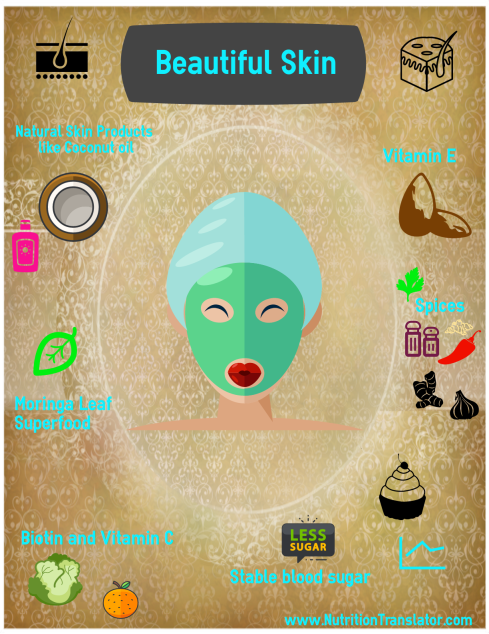
2.9 Let’s Talk About Sex: Reproductive
- Vitamin A: Vitamin A is crucial for healthy bone tissue, vision, proper hormone function and making healthy babies. But plants don’t contain “true” vitamin A—only certain provitamins, particularly beta carotene, that your body converts into vitamin A. Eat Beta-Carotene rich foods with a fat component to help the absorption amount, and be sure to eat beta-carotene rich plant foods daily.
- Zinc: This is an important nutrition because it converts the beta-carotene to Vitamin A. Zinc helps promote natural testosterone levels which can enhance your sexual health and sex drive.
- Vitamin D: Vitamin D deficiency can cause low estrogen in women, which means low sex drive. It also causes low testosterone in men.
- Maca Root: Superfood Maca Root works by releasing chemicals and nutrients that sends message to the pituitary gland, which tells the body how much of each hormone to produce, whether it is producing enough, too much or just the right. It can improve libido, and help with providing relief to symptoms from menopause like hot flashes.
- Summary: Along with getting a variety of beta-carotene rich foods it is important to combine those foods with fat for better absorption of beta-carotene. Make sure you are getting enough zinc rich foods and consider using the Trace Mineral Drops in your water daily talked about earlier. If you feel your hormones may be unbalanced, try including Maca root in your diet to help improve libido, and reduce PMS, and menopause symptoms.
- Recipe:Maca Carrot Soup
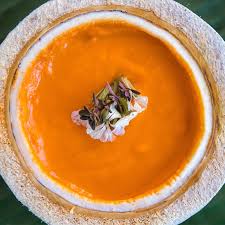
Ingredients:
- 4 cups carrot chopped
- 1/2 yellow onion sliced
- 1-inch piece of fresh ginger chopped
- 2 cups vegetable stock
- 1 16-oz can coconut milk
- 1 cup fresh carrot juice
- 3 teaspoons of Maca
- 6 teaspoons salt
- 3 tablespoons fresh dill chopped
- 1 tbsp pumpkin seeds for topping
Directions:
- Heat a large pot to medium low heat. Add onions and carrot. Cook for 10 minutes or until tender. Add fresh ginger and vegetable stock. Bring to a boil and reduce to a simmer. Cook for 20 minutes. While the soup is reducing, juice the carrots. Add coconut milk to the pot and turn off the heat. Allow the soup to cool slightly and then add in the fresh carrot juice. Season with the Maca, salt and dill. Pour soup into a blender and blend on high for 4 minutes. Serve!
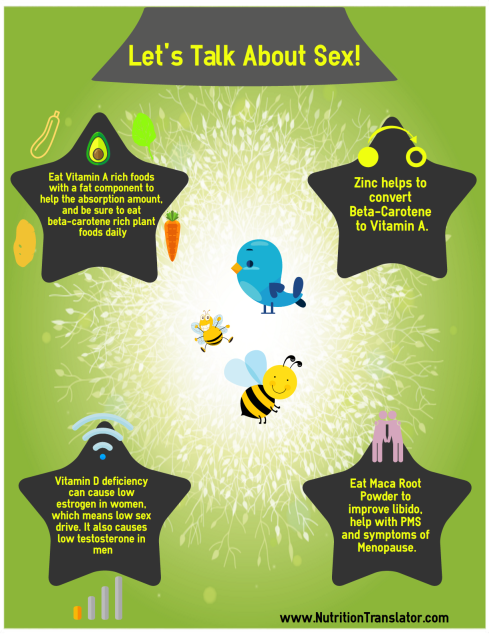
2.10 Powerhouse: Energy
- Mitochondria: The powerhouse. Mitochondria is not considered an organ system, but it is probably one of the most important parts of your body to optimize. I saved the best for last! You can live without food or water for a couple days/week, but without your mitochondria you wouldn’t live for more than a couple seconds. It is vital to have these little guys functioning at optimal levels to keep you energized and preventing disease states like cancer. The tiny factories in each of our cells that turn the food we eat and the oxygen we breathe into energy. The more healthy mitochondria your body contains, the better you’ll feel, and the more robust your metabolism will be. A mighty mitochondrial force translates to better energy and focus, and greater ability to sustain high levels of activity without fatiguing. Progressive loss of function in the mitochondria—the cellular generators responsible for nearly all the body’s energy output—speeds aging and death.
- Detox: Riding heavy metals and detoxing the body from processed foods, chemicals and the environment can help improve mitochondrial health. Include organic cilantro, and chlorella in your diet weekly to help rid heavy metals.
- Shilajit: Long known to Ayurvedic practitioners for its healing power, shilajit is an organic substance harvested from biomass high in the Himalayas. It acts as a powerful adaptogen, providing broad systemic defense against stress and illness. Cutting-edge scientific analysis has isolated humic substances as the principal active ingredients that enhance mitochondrial energy flow. It also contains fulvic acid with helps to carry unwanted chemicals out of the body. I highly recommend the Lotus Blooming Herbs Brand.
- Reduce stress/meditation: Stress is intertwined with all systems especially mitochondrial health. Consider the Headspace app or 10 min guided meditation a day.
- Healthy Fat: Eat healthy fats like avocado, nuts, seeds. Reduce your added sugar intake. Your mitochondria run better off of real food, unprocessed food. Try your best to avoid artificial sweeteners like Acesulfame Potassium and Sucralose which can disrupt your mitochondrial health.
- Exercise: Movement can increase mitochondrial density= more energy
- Summary: I saved the best for last. Mitochondria may be one of the most important parts of your body to optimize. Consider adding in chlorella, cilantro, Shilajit, healthy fats, including moderate exercise, and reducing stress to boost your energy levels.
- Recipe: Detoxifying, Energy Boosting SmoothieCleanse the heavy metals and boost mitochondrial health with this smoothie! Serves 2-3
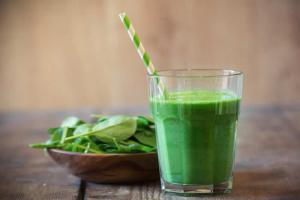
Ingredients:
- 1 cup frozen mango
- 1 green apple or pear
- 1 lemon peeled
- 1 large handful of spinach
- 1 large handful of kale
- 1 small handful of cilantro
- 2 dates pitted
- 1/4th avocado
- 1 thumb of ginger
- 1 teaspoon of chlorella
- 1 grain size portion of Shilajit (Lotus Blooming Herbs brand)
- 2 cups coconut water depending on desired consistency
Directions:
- Throw all ingredients into a high speed blender and blend until smooth. Enjoy!
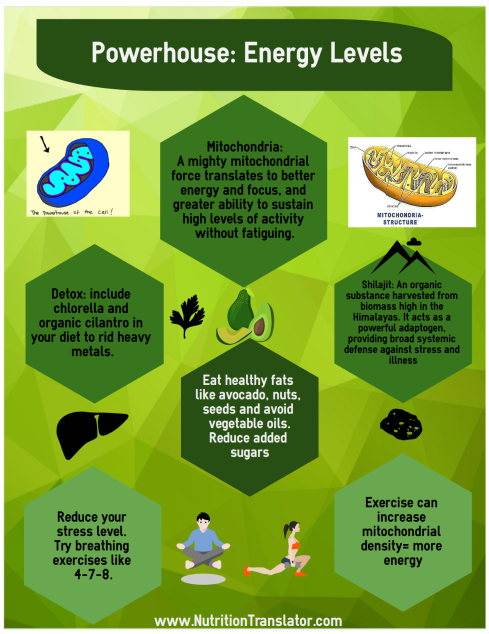
Thank you for reading! If this all seems overwhelming to you, and you would like more guidance on making sure you are meeting all your needs on a vegan diet then let’s work together! Visit my website www.NutritionTanslator.com for more information on my services!
For my 1 week Detox Meal Plan click here.
❤ Colleen Poling, RD




Leave a comment